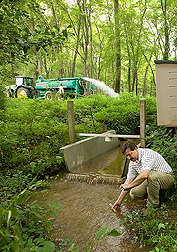E. coli: Alive and Well,
Probably in a Streambed Near You
Escherichia coli is a survivor. It’s at home in the gut of mammals and other vertebrates, but it can also live in soil and water and in biofilms that can form on some moist surfaces.
“Even though most E. coli strains don’t cause illness, it’s an ‘indicator organism’—one that water-quality managers use to measure fecal contamination,” says Agricultural Research Service soil scientist Yakov Pachepsky. “When it’s found in surface water, agriculture or urban runoff is usually implicated as the source. But it can also come from wildlife, leaking septic tanks, or even irrigation equipment, so we need to know more about the sources of E. coli in the environment.”
Another spot where many strains of E. coli lurk is in streambed sediments. Pachepsky is conducting studies with microbiologist Daniel Shelton and other scientists at the ARS Environmental Microbial and Food Safety Laboratory in Beltsville, Maryland, to learn more about where the pathogens in streambeds come from, where they end up, and how long they can survive.
Working with University of Maryland Environmental Science and Technology professor Robert Hill and honors student Amanda Garzio-Hadzick, Pachepsky collected streambed sediments and surface water from three sites along Beaverdam Creek in Beltsville. Then they added some dairy manure slurry to the samples, which increased nonpathogenic E. coli levels in the sediments and water.
Lab studies indicated that the bacteria survived much longer in the sediments than in the water and that they lived longer when levels of organic carbon and fine sediment particles were higher. They also found that when organic carbon levels were higher, water temperatures were less likely to affect survival rates—and they published the first evidence that E. coli can overwinter in the sediment.
The ARS team also evaluated whether adding data about the deposition and release of E. coli in streambeds would improve computer simulations of microbial water quality. They collected 3 years of data on streamflow, weather, and E. coli levels in water and sediments from a Pennsylvania stream fed by several smaller tributaries. Then they used the information to calibrate the Soil and Water Assessment Tool (SWAT), a computer model developed by ARS scientists that predicts how farming practices affect water quality on a watershed scale.
The resulting simulations indicated that bacterial releases from the streambed persistently degraded water quality and that pasture runoff only contributed to E. coli levels in nearby streams during temporary interludes of high waterflows. The team concluded that SWAT simulations would overestimate how much pasture runoff contributes to surface water contaminated with E. coli, unless the model included data on E. coli levels in streambed sediments.
“Now we want to look more closely at why E. coli doesn’t die in the sediment. Is it because of contributions from wildlife or from high-flow events? This is still a big unknown,” says Pachepsky. He adds, “The mud is something not many people are interested in. But it could change our conception of microbial water quality.”—By Ann Perry, Agricultural Research Service Information Staff.
This research is part of Water Availability and Watershed Management (#211) and Food Safety (#108), two ARS national programs described at www.nps.ars.usda.gov.
To reach scientists mentioned in this story, contact Ann Perry, USDA-ARS Information Staff, 5601 Sunnyside Ave., Beltsville, MD 20705-5129; (301) 504-1628.
"E. coli: Alive and Well, Probably in a Streambed Near You" was published in the July 2011 issue of Agricultural Research magazine.







